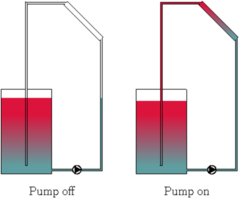WP1-6 Design, investigation, and modelling of innovative Solar Drainback Systems
Supervisor(s)
Hosted by: | University of Kassel |
|---|---|
Student: | Yoann Louvet |
Started: | 02/2014 |
Supervisor(s): | Klaus Vajen (University of Kassel) |
Short description

The objective of this PhD is to investigate DBS and acquire better knowledge on their functioning in order to propose an optimal system configuration with regards to solar collector loop efficiency and costs. Several DBS configurations already exist therefore the thesis will have to find out which configuration is optimal depending on given boundary conditions (system height, collector area, etc.). To achieve this result, the gains compared to conventional systems and between DBS variations themselves should be assessed. The focus will be on large systems (in comparison with systems for single family houses).
The European solar thermal market has been dropping in the last years since its peak in 2008. Reducing investment and operation costs is a main challenge the industry has to face to restrain this decrease. Drainback systems (DBS) present characteristics which could contribute to reach this target. Indeed they require fewer and cheaper components than conventional systems, are safe regarding overheating and freezing risks therefore lowering the needs for maintenance, and at the same time they contribute to improve the efficiency of the solar collector loop. However, despite being known for more than 30 years, DBS are widespread in a few countries only, and the scientific literature available to describe their functioning is limited and dates back a few decades ago.
A first step consisted in gathering, summarizing and analysing the available literature related to DBS to get a deep insight on the topic. A mapping of system design possibilities and special issues to be tackled was established based on this work. In addition, practical knowledge was gained from the monitoring of existing DBS (some of them having a collector area larger than 100 m²) installed during the previous years by the company Fsave Solartechnik GmbH. Based on those findings and taking into account Fsave's products characteristics (non-pressurized heat storages), different system designs are investigated and simulated with the objective to maximise both system and cost efficiency. For those purposes, different materials and components available on the market and suitable for DBS applications will also be compared. A special focus was also put on developing a method aiming at controlling the safe functioning of DBS, by ensuring that no water pocket remains after the draining of the system. One of the main impediments to DBS development is indeed the necessity to carefully install collectors and pipework, otherwise leading to serious damages of the system.
Experimental set-up:
In order to test the behaviour of DBS and gain knowledge, a test facility was build up during the project. Moreover additional sensors were installed on existing solar collector fields in order to gather relevant data. Finally in depth experiments were carried out to develop a method to control the safe draining of a DBS.
Numerical tools:
- Model for pressure drops and system pressure: Excel + VBA
- Analysis of data from existing plants: Excel + VBA/TRNSYS
- Drainback system modelling: TRNSYS
Working plan and current status:
- Comprehensive review of existing literature on DBS (done)
- Measurements, analysis and evaluation of existing DBS (on-going)
- Design and construction of a test facility (done)
- System testing and validation (on-going)
- Development of methods for testing the safe functioning of DBS (done)
- Modelling, model calibration and validation (on-going)
- Proposition of an optimal system configuration function of boundary conditions (on-going)
The work started with parallel activities in order to get a deep insight into the topic. On the one hand, an intensive literature research was carried out to gather, analyse and summarize available knowledge related to drainback systems (DBS). Few scientific publications were found, but a large amount of material was discovered in patents. The results of this investigation were published in a joint journal article with the Technical University of Denmark. A mapping of system design possibilities and special issues to be tackled was established based on this work. On the other hand, practical knowledge was gained from the monitoring of existing DBS installed during the previous years by the company Fsave Solartechnik GmbH. Details about these studies were published in two different conference papers. Those first results are paving the way for a more comprehensive analysis, based on extended simulations and a detailed cost analysis enabling to compare different drainback designs but also drainback and conventional systems.
A special focus was also put on developing a method aiming at controlling the safe functioning of DBS, by ensuring that no water pocket remains after the draining of the system. One of the main impediments to DBS development is indeed the necessity to carefully install collectors and pipework, otherwise leading to serious damages of the system. A method was developed and tested in the laboratory but also on existing systems, showing promising results.
Due to the difficulties encountered by Fsave Solartechnik GmbH, the student is now working at the University of Kassel. However he keeps having close contact with the industry, working with EnerSolve GmbH, notably for the monitoring of newly installed drainback systems.
The student is also taking part in the IEA-SHC Task 54. As drainback systems present a good potential for costs reduction, it is relevant to participate in this task focusing on the price reduction of solar thermal systems. The objective is to share knowledge about DBS but also to gain input from other projects.
